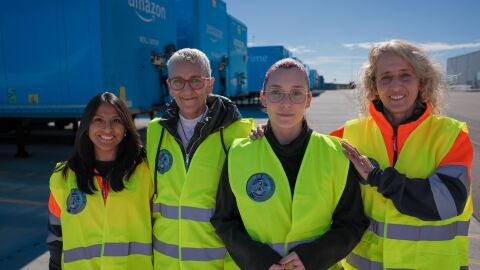Amazon will launch its first 20 electric heavy goods vehicles (eHGVs) in Germany by year end. Our first eHGVs in Germany mark an important milestone toward electrifying the hard-to-abate “middle mile” transportation industry, the area of the freight industry that moves cargo between warehouses. The vehicles brings Amazon one-step closer to decarbonizing its fleet and becoming net-zero carbon by 2040, ten years ahead of the goal set by the Paris Agreement.
Amazon is doing its part to minimize the carbon footprint of the German transportation sector by replacing traditional heavy goods vehicles with zero-emission eHGVs. The 20 eHGVs are expected to drive more than one million road kilometers annually, fuelled with electricity instead of diesel. The eHGVs are made by Volvo Trucks, and will transport products from our Dortmund and Dusseldorf sites.
Using the latest innovations in battery technology, the electric trucks will use 360kW electric charging points, capable of charging the 40-tonne trucks in less than two hours. Amazon has installed ten of these best-in-class fast chargers across its sites in Germany.
“Amazon is committed to decarbonizing its fleet, and the middle mile is a notoriously hard-to-abate sector,” said Andreas Marschner, Vice President Transportation Services Europe at Amazon. “That’s why welcoming these electric heavy goods vehicles to our fleet is such a critical milestone. We’re operating one of the fastest-growing commercial transportation electrification programs, and we’ll continue to invest and innovate to decarbonize and deliver packages to customers with zero emissions.”
“Big actors in the transport business play a very important role in leading the industry’s efforts to lower its carbon footprint. Therefore I’m glad that Amazon is going electric with us on their heavier transport assignments.”
“We need more trucks with alternative drive systems on Germany’s roads to make road freight transport more sustainable and for us to comply with European requirements. Companies are interested in converting their fleets to clean drive systems. This is demonstrated by our support program, with which we have already enabled the purchase of more than 1,200 vehicles with electric and hydrogen drive systems. This targeted support is part of our overall Climate-friendly Commercial Vehicles concept. That is the central roadmap for implementing climate protection measures in road freight transport by 2030, and we are relying on a package of measures comprising support, management of the development of alternative refueling and charging infrastructure, and an appropriate regulatory framework. We can only achieve the tasks ahead of us through joint and targeted action by all stakeholders. That is why it is good when companies, such as Amazon as a user and Volvo as a manufacturer, work together to reduce CO2 emissions in road freight transport,” says Oliver Luksic, Parliamentary State Secretary to the Federal Minister for Digital and Transport.
The eHGVs join Amazon’s growing fleet of zero-emission vehicles. Amazon already has more than 1,200 electric delivery vans on the road in Germany. Last year, Amazon delivered more than 40 million packages to customers’ doors in Germany by using zero-emission electric vans and e-cargo bikes, and that number will grow as Amazon continues to expand its zero emissions fleet.
Launching its first eHGVs in Germany is part of Amazon’s efforts to embed decarbonization strategies throughout its business. The company is on a path to powering its operations with 100% renewable energy by 2025, and in 2021 it reached 85%. This applies to all Amazon operations such as corporate offices, physical stores, and logistics facilities, including on-site charging points. Amazon now has more than 100 renewable energy projects across Europe and just completed two large solar projects on the roofs of its newest fulfilment centers in Hof-Gattendorf (Bavaria) and Kaiserslautern (Rheinland-Pfalz). The on-site installations have a total capacity of 7.7 megawatt (MW) and are Amazon’s third and fourth largest rooftop solar sites in Europe connected to date. Additionally, the company plans to increase the number of facilities with on-site solar in Germany to 14 sites total by 2024. Once all 14 sites are operational, the portfolio of rooftop solar projects is expected to produce enough energy to power the equivalent of more than 13,000 German homes each year. This is in addition to investments the company has made in large-scale off-site renewable energy in Germany, including a 350 MW capacity off-shore wind farm in the North Sea expected to come online in 2025. Once operational, it is expected to produce enough energy to power the equivalent of more than 450,000 German homes each year.
Amazon co-founded The Climate Pledge in 2019, a commitment to become net-zero carbon by 2040. Amazon has phased out single-use plastic packaging in its German fulfilment centers and will continue to act boldly to address climate change and to invest in solutions that help meet the company’s net-zero commitment.












